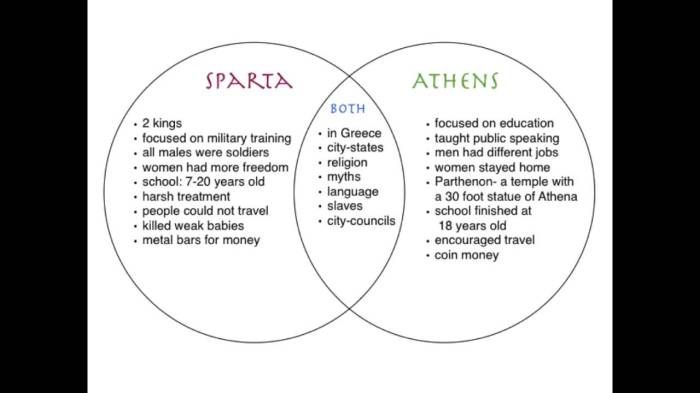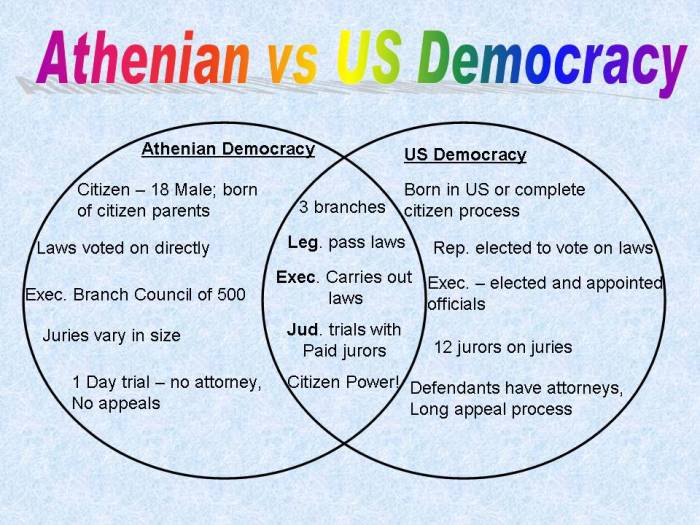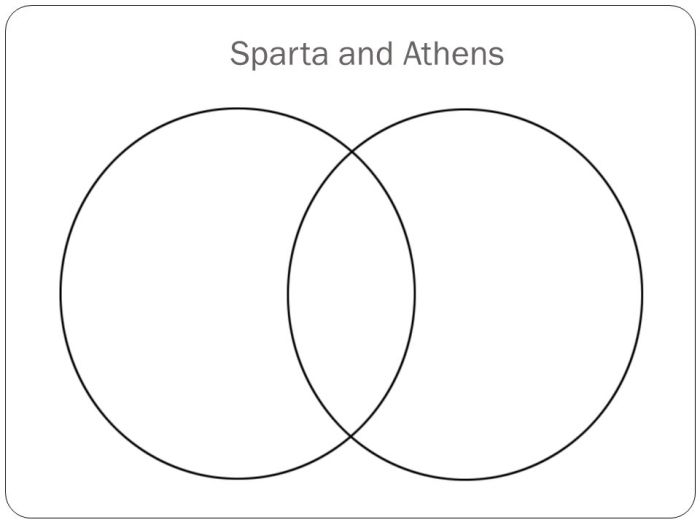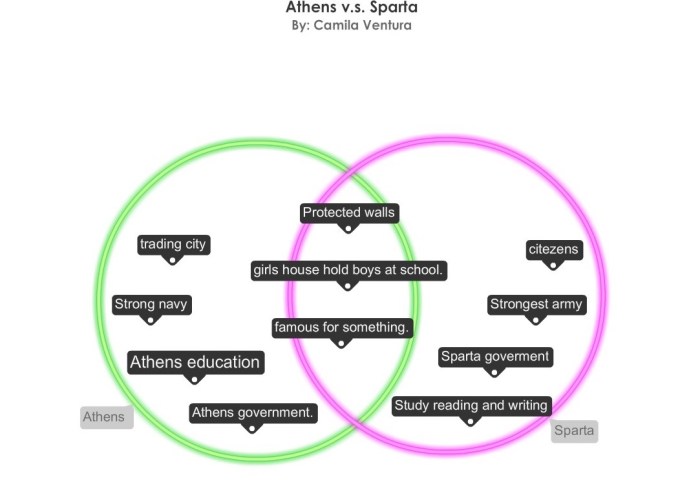The Venn diagram for Athens and Sparta provides a captivating visual representation of the key similarities and differences between these two prominent city-states of ancient Greece. This analysis delves into their historical context, political systems, social structures, military prowess, and cultural achievements, offering a comprehensive understanding of their contrasting yet interconnected nature.
Athens, renowned for its democratic governance and flourishing cultural scene, stands in contrast to Sparta, known for its militaristic society and oligarchic system. By examining these aspects through the lens of a Venn diagram, we gain a deeper appreciation of the complexities and nuances that shaped these ancient civilizations.
Historical Context
Athens and Sparta were two prominent city-states in ancient Greece that played a significant role in shaping Greek civilization. Athens was known for its democratic system and cultural achievements, while Sparta was renowned for its military prowess and oligarchic government.
The rivalry between Athens and Sparta reached its peak during the Peloponnesian War (431-404 BCE), which ended with Sparta’s victory. This conflict had a profound impact on both city-states and on the course of Greek history.
Political Systems

Athens
Athens had a democratic system of government, where citizens had the right to participate in the assembly and vote on laws. The assembly was the supreme governing body of Athens, and it made decisions on a wide range of issues, including war, peace, and taxes.
Sparta, Venn diagram for athens and sparta
Sparta, on the other hand, had an oligarchic system of government, where power was concentrated in the hands of a small group of wealthy landowners. The Spartan assembly was dominated by these landowners, and it had limited power compared to the assembly in Athens.
Social Structure: Venn Diagram For Athens And Sparta

Athens
Athenian society was divided into three main classes: citizens, metics (resident foreigners), and slaves. Citizens had full political rights, while metics had limited rights. Slaves had no rights and were considered property.
Sparta, Venn diagram for athens and sparta
Spartan society was also divided into three main classes: citizens (Spartiates), perioeci (free non-citizens), and helots (slaves). Spartiates were the only full citizens and had political rights. Perioeci were free but had no political rights. Helots were slaves who worked the land for the Spartiates.
Military Prowess
Athens
Athens had a powerful navy that was essential to its success in the Peloponnesian War. Athenian ships were faster and more maneuverable than Spartan ships, and they were equipped with a new weapon called the trireme, which gave Athens a significant advantage in naval battles.
Sparta, Venn diagram for athens and sparta
Sparta had a powerful army that was based on the hoplite phalanx. Hoplites were heavily armed infantrymen who fought in close formation. The Spartan phalanx was one of the most effective fighting forces in the ancient world, and it was responsible for Sparta’s victory in the Peloponnesian War.
Cultural Achievements

Athens
Athens was a major center of culture and learning in the ancient world. The city was home to some of the greatest philosophers, artists, and writers of all time, including Socrates, Plato, Aristotle, Sophocles, and Euripides.
Sparta, Venn diagram for athens and sparta
Sparta was not as culturally advanced as Athens, but it did produce some notable poets and musicians. The Spartan poet Tyrtaeus wrote stirring war songs that inspired the Spartan army to victory in the Peloponnesian War.
Venn Diagram Creation

| Athens | Sparta | |
|---|---|---|
| Political System | Democratic | Oligarchic |
| Social Structure | Citizens, metics, slaves | Spartiates, perioeci, helots |
| Military Prowess | Powerful navy, triremes | Powerful army, hoplite phalanx |
| Cultural Achievements | Major center of culture and learning | Produced some notable poets and musicians |
FAQ Guide
What is the significance of Athens and Sparta in ancient Greece?
Athens and Sparta were two of the most powerful and influential city-states in ancient Greece. Athens was renowned for its democratic government, cultural achievements, and philosophical thought, while Sparta was known for its militaristic society and oligarchic system.
How did the political systems of Athens and Sparta differ?
Athens had a democratic system, where all male citizens could participate in the assembly and vote on laws. Sparta, on the other hand, had an oligarchic system, where power was concentrated in the hands of a small group of wealthy and powerful individuals.
What were the key similarities and differences in the social structures of Athens and Sparta?
Both Athens and Sparta had a hierarchical social structure, with citizens at the top, followed by foreigners, and then slaves. However, the social structure of Sparta was more rigid and militaristic than that of Athens.
How did the military prowess of Athens and Sparta compare?
Athens had a powerful navy, while Sparta had a formidable army. The Athenian navy was instrumental in defeating the Persian invasion of Greece, while the Spartan army was renowned for its discipline and effectiveness in land warfare.
What were the cultural achievements of Athens and Sparta?
Athens was a center of art, literature, and philosophy. The city was home to some of the greatest thinkers and artists of the ancient world, including Socrates, Plato, and Aristotle. Sparta, on the other hand, was more focused on military training and discipline, and its cultural achievements were more limited.